Adipose tissue as a key player in obstructive sleep apnoea
- PMID: 31243096
- PMCID: PMC9488701
- DOI: 10.1183/16000617.0006-2019
Adipose tissue as a key player in obstructive sleep apnoea
Abstract
Obstructive sleep apnoea (OSA) is a major health concern worldwide and adversely affects multiple organs and systems. OSA is associated with obesity in >60% of cases and is independently linked with the development of numerous comorbidities including hypertension, arrhythmia, stroke, coronary heart disease and metabolic dysfunction. The complex interaction between these conditions has a significant impact on patient care and mortality. The pathophysiology of cardiometabolic complications in OSA is still incompletely understood; however, the particular form of intermittent hypoxia (IH) observed in OSA, with repetitive short cycles of desaturation and re-oxygenation, probably plays a pivotal role. There is fast growing evidence that IH mediates some of its detrimental effects through adipose tissue inflammation and dysfunction. This article aims to summarise the effects of IH on adipose tissue in experimental models in a comprehensive way. Data from well-designed controlled trials are also reported with the final goal of proposing new avenues for improving phenotyping and personalised care in OSA.
Copyright ©ERS 2019.
Conflict of interest statement
Conflict of interest: S. Ryan has nothing to disclose. Conflict of interest: C. Arnaud has nothing to disclose. Conflict of interest: S.F. Fitzpatrick has nothing to disclose. Conflict of interest: J. Gaucher has nothing to disclose. Conflict of interest: R. Tamisier has nothing to disclose. Conflict of interest: J-L. Pépin reports grants and research funds from Air Liquide Foundation, grants and personal fees from Agiradom, AstraZeneca, Philips and Resmed, grants from Fisher and Paykel and Mutualia, grants from Vitalaire, and personal fees from Boehringer Ingelheim, Jazz Pharmaceuticals, Night Balance and Sefam, outside the submitted work.
Figures


References
-
- Nedergaard J, Bengtsson T, Cannon B. Unexpected evidence for active brown adipose tissue in adult humans. Am J Physiol Endocrinol Metab 2007; 293: E444–E452. - PubMed
-
- Hotamisligil GS, Shargill NS, Spiegelman BM. Adipose expression of tumor necrosis factor-alpha: direct role in obesity-linked insulin resistance. Science 1993; 259: 87–91. - PubMed
Publication types
MeSH terms
Substances
LinkOut - more resources
Full Text Sources
